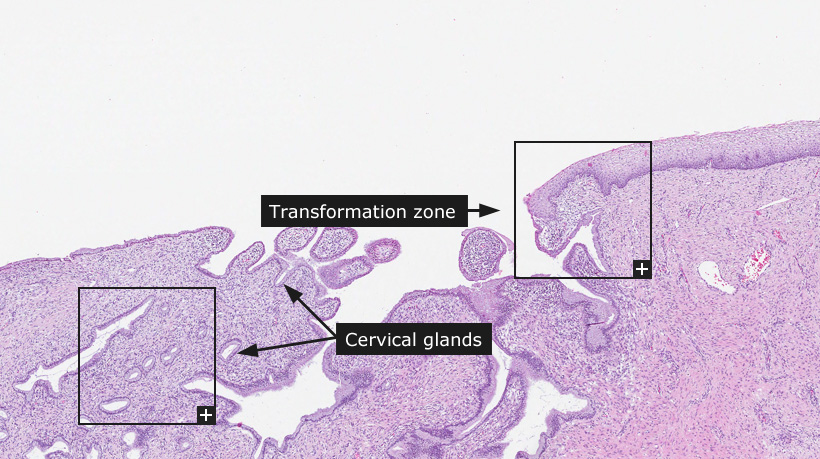Cervix, uterine

Cervix, uterine
The cervix measures around 2–3 centimeters in length. It is part of the female reproductive system situated between the vagina and the uterine body. The cervix is composed of fibrous, muscular and elastic tissue lined with columnar and squamous epithelium.
The lower part of the cervix is known as the ectocervix and is composed of non-keratinized stratified squamous epithelium, resembling the vaginal epithelium. However, it usually lacks the rete pegs seen in the vagina. The ectocervix is comprised of three zones: 1) the germinal cell layer containing basal cells, where proliferation takes place, 2) the intermediate or midzone, termed stratum spinosum, where maturation occurs, and 3) the superficial zone, which contains terminally differentiated cells that eventually exfoliate. Basal cells are oval with scant cytoplasm and perpendicular to the basement membrane. Maturation in stratum spinosum is characterized by an increase in cytoplasmic volume with the accumulation of glycogen, which is responsible for the clear, vacuolated appearance of cells in the upper layers of the epithelium. Cells in the superficial zone are flat, have an abundant, eosinophilic cytoplasm and pyknotic nuclei.The mucosa covering the ectocervix is known as the exocervix.
The cervical canal, connecting the vagina with the uterine body, is lined with simple columnar epithelium and contains underlying glandular structures. This is known as the endocervix. These "cervical glands" have been shown by three-dimensional studies to be, not "true" glands but deep, cleft-like infoldings of the surface epithelium into the underlying stroma. In cross section, the complex infoldings appear as isolated glands. The columnar cells have basal round or oval nuclei and finely granular cytoplasm containing abundant mucin. Mitotic activity is not observed in endocervical cells under normal circumstances.
The junction between the endocervix and the ectocervix is called the squamocolumnar junction. The location of this junction shifts with age: the columnar epithelium in the cervical canal role outwards onto the ectocervix. Over time, the columnar epithelium is replaced by metaplastic squamous epithelium. The newly formed squamocolumnar junction is termed the "new" squamocolumnar junction. The area between the original and the new squamocolumnar junction is called the transformation zone. It is here that most cervical cancers arise.
Cancer: Cervical cancer
|